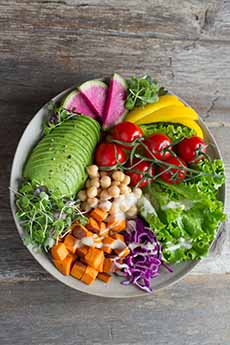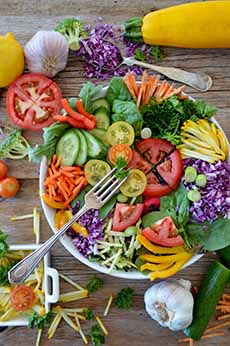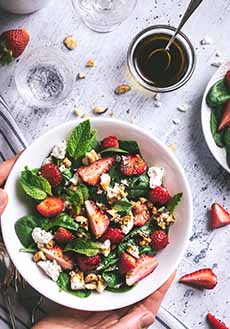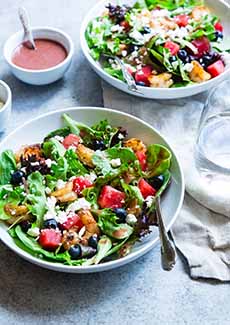Avocado & Orange Composed Salad Recipe For National Salad Month…& How To Structure A Salad
|
|
May is National Salad Month, a time to explore new recipes, as attached as you may be to your current ones. There are many types of salads, the major categories of which are: Salads can be served as appetizers/first courses, entrées, sides, and desserts. Dessert salads can be sweetened, molded, or even frozen, and can be combined with fruit gelatin, whipped cream, or sour cream. Salads can be composed (photos #1, #2, #3, #4) or tossed (photos #5, #6, #7). > You’ll also find a template for the perfect vinaigrette. But first: Culinary students learn that the structure of a salad includes the Base, Body, Dressing and Garnish. Thanks to the Utah Education Network for this information. You can use a standard navel orange, but the visual and palate appeal of cara cara oranges and blood oranges gives the recipe an added lift. You can also substitute red grapefruit. Thanks to Food & Wines From Spain for the recipe (photo #1). For a wine pairing, wine specialist Adrienne Smith suggests Malvasía. “There is something about a young and aromatic, dry Malvasía wine made in the Canary Islands that goes well with just about anything,” she says. “Delicate enough to not overpower the avocado, but at the same time bold enough to match the acidity of the oranges, these wines from areas like Lanzarote* are hard to beat.” Prep time is 30 minutes or less. > The history of blood oranges. > The history of cara cara oranges. 1. PREPARE the oranges. Slice off the tops and bottoms and then cut off the peel and pith, following the curve of the fruit. Next, holding each orange over a sieve placed on top of a bowl to catch the juice, cut along the membranes to release each segment. Squeeze out any juice from the pulp and discard. 2. MAKE the dressing. Place the olive oil, vinegar, salt, and black pepper into a jar and emulsify using a hand-held stick blender. Alternatively, shake the mixture in a screw-topped jar. Add the reserved orange juice and mix again. When ready to serve: 3. HALVE the avocado, remove the stone and peel off the skin. Cut the flesh crossways into slices. Place the greens on the plate, arrange the avocado slices and orange segments on top and drizzle the dressing. Garnish with parsley and red onion as desired. – Keep washed and drained greens wrapped in a dry paper towel and refrigerate in a plastic container or a large plastic bag. Vinaigrette is an emulsion of oil, vinegar, and seasoning. The seasoning can be as simple as salt and pepper but can have added citrus zest, fruits (puréed), herbs (including prepared herbs, like horseradish and wasabi), mustard, and spices. The classic formula for a vinaigrette is 3 parts oil to 1 part acid. The acid is typically vinegar but can be citrus juice, or a combination of both. Oil. Any culinary oil can be used. Olive oil is standard, but less expensive oils such as canola, corn, grapeseed, and sunflower can be substituted. Nut oils are especially delicious, as is sesame oil. If using dark sesame oil, which is very strong, you should blend it with olive oil or one of the other mild oils. Vinegar. Any kind of vinegar works, from apple cider to balsamic to red or white wine to rice vinegar. Check out the different types of vinegar. Seasonings. If using mustard or puréed fruit, you can substitute it for a portion of the acid. It can be just a hint, e.g. 1/8 teaspoon, or a full-out Dijon mustard or strawberry vinaigrette, made by substituting 1/3 of the vinegar/acid. You can also substitute citrus juice (grapefruit, lemon, lime, orange, yuzu) for 1/3 to 100% of the vinegar. _______________ *Lanzarote is a Spanish Denominación de Origen Protegida (D.O.P. for wines. It encompasses the entire island of Lanzarote, in the Canary Islands. The Canaries are a Spanish region and archipelago in the Atlantic Ocean, in Macaronesia. At their closest point to the African mainland, they are 62 miles west of Morocco. |
|
|
CHECK OUT WHAT’S HAPPENING ON OUR HOME PAGE, THENIBBLE.COM. |
||









